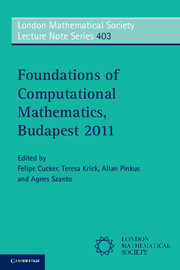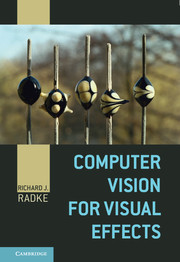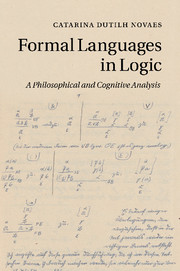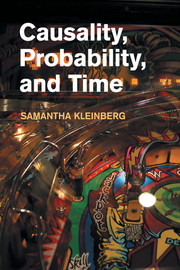Refine search
Actions for selected content:
48287 results in Computer Science

Foundations of Computational Mathematics, Budapest 2011
-
- Published online:
- 05 December 2012
- Print publication:
- 15 November 2012

Computer Vision for Visual Effects
-
- Published online:
- 05 December 2012
- Print publication:
- 19 November 2012
JFP volume 23 issue 1 Cover and Back matter
-
- Journal:
- Journal of Functional Programming / Volume 23 / Issue 1 / January 2013
- Published online by Cambridge University Press:
- 05 December 2012, pp. b1-b2
-
- Article
-
- You have access
- Export citation

Formal Languages in Logic
- A Philosophical and Cognitive Analysis
-
- Published online:
- 05 December 2012
- Print publication:
- 08 November 2012

Causality, Probability, and Time
-
- Published online:
- 05 December 2012
- Print publication:
- 12 November 2012
GEM: A distributed goal evaluation algorithm for trust management
-
- Journal:
- Theory and Practice of Logic Programming / Volume 14 / Issue 3 / May 2014
- Published online by Cambridge University Press:
- 03 December 2012, pp. 293-337
-
- Article
- Export citation
Ternary quadratic forms and half-integral weight modular forms
- Part of
-
- Journal:
- LMS Journal of Computation and Mathematics / Volume 15 / May 2012
- Published online by Cambridge University Press:
- 01 December 2012, pp. 418-435
-
- Article
-
- You have access
- Export citation
Matching simple modules of condensation algebras
- Part of
-
- Journal:
- LMS Journal of Computation and Mathematics / Volume 15 / May 2012
- Published online by Cambridge University Press:
- 01 December 2012, pp. 374-384
-
- Article
-
- You have access
- Export citation
Differential equations and expansions for quaternionic modular forms in the discriminant 6 case
- Part of
-
- Journal:
- LMS Journal of Computation and Mathematics / Volume 15 / May 2012
- Published online by Cambridge University Press:
- 01 December 2012, pp. 385-399
-
- Article
-
- You have access
- Export citation
Bayesian approaches to acoustic modeling: a review
-
- Journal:
- APSIPA Transactions on Signal and Information Processing / Volume 1 / December 2012
- Published online by Cambridge University Press:
- 06 December 2012, e5
- Print publication:
- December 2012
-
- Article
-
- You have access
- Open access
- HTML
- Export citation
Examples of linear multi-box splines
- Part of
-
- Journal:
- LMS Journal of Computation and Mathematics / Volume 15 / May 2012
- Published online by Cambridge University Press:
- 01 December 2012, pp. 444-462
-
- Article
-
- You have access
- Export citation
Latent acoustic topic models for unstructured audio classification
-
- Journal:
- APSIPA Transactions on Signal and Information Processing / Volume 1 / December 2012
- Published online by Cambridge University Press:
- 10 December 2012, e6
- Print publication:
- December 2012
-
- Article
-
- You have access
- Open access
- HTML
- Export citation
Minimal models for rational functions in a dynamical setting
- Part of
-
- Journal:
- LMS Journal of Computation and Mathematics / Volume 15 / May 2012
- Published online by Cambridge University Press:
- 01 December 2012, pp. 400-417
-
- Article
-
- You have access
- Export citation
Algorithmic construction of Chevalley bases
- Part of
-
- Journal:
- LMS Journal of Computation and Mathematics / Volume 15 / May 2012
- Published online by Cambridge University Press:
- 01 December 2012, pp. 436-443
-
- Article
-
- You have access
- Export citation
ROB volume 31 issue 1 Cover and Front matter
-
- Article
-
- You have access
- Export citation
ROB volume 31 issue 1 Cover and Back matter
-
- Article
-
- You have access
- Export citation
NLE volume 19 issue 1 Cover and Back matter
-
- Journal:
- Natural Language Engineering / Volume 19 / Issue 1 / January 2013
- Published online by Cambridge University Press:
- 28 November 2012, pp. b1-b8
-
- Article
-
- You have access
- Export citation
A survey on metrics for the evaluation of user simulations
-
- Journal:
- The Knowledge Engineering Review / Volume 28 / Issue 1 / March 2013
- Published online by Cambridge University Press:
- 28 November 2012, pp. 59-73
-
- Article
- Export citation
NLE volume 19 issue 1 Cover and Front matter
-
- Journal:
- Natural Language Engineering / Volume 19 / Issue 1 / January 2013
- Published online by Cambridge University Press:
- 28 November 2012, pp. f1-f2
-
- Article
-
- You have access
- Export citation
